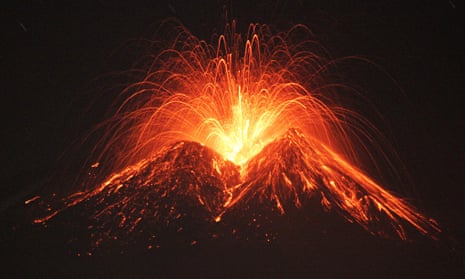The island of Sumbawa in what is now Indonesia began to crack apart 200 years ago this week. On 10 April 1815, an explosion that could be heard a thousand miles away announced the largest volcanic eruption in recorded history. Mount Tambora, once among the highest peaks in the East Indies, was blown in half. Thousands in the immediate vicinity were killed by lava, wind, ash, fire and tsunamis, but the volcano’s effects echoed far further and longer. The force of the explosion catapulted millions of tonnes of sulphur miles upwards into the stratosphere where it was held aloft. A haze encircled the planet, providing it with a temporary sunshade. Over the next three years, Tambora cooled the surface of the planet by a degree celsius.
In Europe and America, crops failed, diseases flourished and riots and famine broke out. The year 1816 became known as the “year without a summer”. Farmers, philosophers, artists and writers struggled to make sense of their new weather. In a recent book Gillen D’Arcy Wood describes the indelible mark the volcano has left on our culture. In England, Constable and Turner used unusual quantities of red paint as they reproduced the vivid volcanic sunsets. In June 1816, as snow fell in New York, four friends on the shores of Lake Geneva were kept inside by relentless rain and storms. The ghost stories that they told one another led to Tambora’s most famous cultural offshoot, Frankenstein. Mary Shelley described in her introduction the “wet, ungenial summer” that inspired her parable of irresponsible science, which she subtitled “The Modern Prometheus”.
More recently, massive volcanic eruptions have given some scientists cause for hope as well as fear. The 1991 eruption of Mount Pinatubo was only a fifth of the size of Tambora, but the machinery of climate science was in place to watch its impact on the planet. Over two years, Pinatubo cooled the Earth by about half a degree. It wrought its own meteorological havoc, but it also provided data in support of a Promethean idea: if a dumb volcano can clumsily cool the planet with a relatively small chemical injection into the stratosphere, then surely the combined might of 21st‑century innovation should be able to provide a bespoke climatic thermostat.
The possibility of geoengineering or, as a report earlier this year from the US National Academy of Sciences rebadged it, “climate intervention”, began as a cold war techno-fancy. In the 1960s, as global warming first came to political attention in the US, the presumption was that technology would be our salvation. The first option, removing greenhouse gases from the atmosphere, would mean brute-force reverse-engineering of the industrial revolution. The alternative, reflecting sunlight, was presented as comparatively easy. The only challenge was in getting chemicals up to the stratosphere. Various options were suggested: aeroplanes, missiles and giant helium balloons with hoses. However, the more environmental scientists learned about the precarious balance of the Earth system, the further geoengineering fell out of fashion. Mitigation of climate change seemed the only sensible option, with scientists warning of the dangers of fossil fuel burning and joining calls to, as the Guardian puts it, “keep it in the ground”.

The taboo on geoengineering didn’t last long. Climate scientists were burdened with knowing the effects of our continued pollution. Humanity’s responsibility for the climate was becoming ever clearer, as was the extent of our neglect. Repeated failures of international climate talks contributed to a profound sense of despair among scientists and environmentalists. In 2006, Paul Crutzen, who had won a Nobel prize for explaining the hole in the ozone layer, gave geoengineering a veneer of respectability, arguing that it could be a sword with which to cut the Gordian knot of climate change.
Geoengineering is Ted-talk innovation: a seductive “Why not?” idea, inspired by nature, whose uncertainties won’t fit an 18-minute slideshow. As with other technological fixes, it demands a form of magical thinking. There would be nothing cheap, quick and easy about geoengineering. The latest report from the Intergovernmental Panel on Climate Change makes clear that carbon dioxide remains in the atmosphere for generations. Even if we were able to shade the planet, the technology would only mask the problem. Withdrawal would require unimaginable societal willpower, not least because the accumulated greenhouse gases would cause the climate to switch to a new state within months once the geoengineering machines were turned off.
The number of scientists interested in geoengineering is growing. Most still find the idea distasteful, but there is a palpable sense of excitement about running experiments on computer models as well as on the environment itself. As we approach the 200th birthday of Frankenstein, its message seems more relevant than ever. Experiments with potentially monstrous ramifications should be handled with care.

Comments (…)
Sign in or create your Guardian account to join the discussion